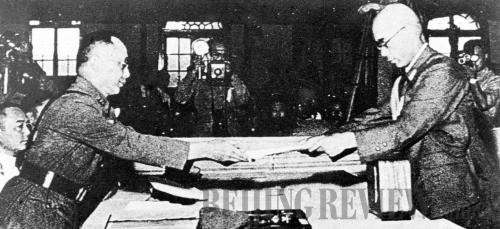

END OF THE WAR: On September 9, 1945, He Yingqin (left), representative of the Chinese Government and the Southeast Asia Ally Forces, accepts the Japanese army's instrument of surrender in Nanjing, then China's capital (XINHUA)
When addressing the 77th anniversary of the Lugou Bridge Incident on July 7, which marks the beginning of the full-scale war, Chinese President Xi Jinping said, "History is history and facts are facts. Nobody can change either."
"Anyone who intends to deny, distort or beautify the history of aggression will never be tolerated by Chinese people or people of other countries," said Xi, referring to widespread concerns that Japan is trying to misrepresent the history of the war.
"Xi's speech again clarifies China's tough stance against Japan's moves," said Ling Xingguang, Director of the Tokyo-based Sino-Japanese Relationship Institute.
"It's a pity that a small minority of people still ignore iron-clad history and the fact that tens of millions of innocent people lost their lives," Xi said in his speech.
When China and Japan normalized bilateral relations in 1972, it was listed in their joint declaration that Japan should view history without bias and not deny its historical aggression against China. That commitment was considered a cornerstone for bilateral political ties and a prerequisite for improving relations.
"Where Sino-Japanese ties will head in the future will be decided by which kind of political attitude, be it the win-win or the zero-sum mentality, that Japan's Abe government takes toward China," said Liu Jiangyong, Deputy Director of the Institute of International Studies at Tsinghua University.
"It is too early to say if Japan will revive its pre-war militarism, but the disclosed strategy of the Abe Cabinet regarding China as a military rival should remind the latter of the urgent need for maintaining peace both domestically and in East Asia," Liu said.
Some Japanese media outlets have started to call for serious improvements to diplomatic relations with China and South Korea through policy shifts, said Ling of the Tokyo-based Sino-Japanese Relationship Institute.
"The latest boost in cooperation between China and South Korea marked by Xi's visit to Seoul made a considerable impact on Japan. Xi's unprecedented presence at the commemoration on July 7 also exerts pressure on Abe. We hope these influences will strengthen the friendly voices," he said.
Ma Junwei, a scholar at the China Institute of Contemporary International Relations, said he believed Sino-Japanese relations will continue to grow in the long run with periodic ups and downs, and he gave the recent foreign ministers' meeting on August 9 as an example of an upturn.
Main Phases of China's War Against Japanese Aggression
First Phase: July 1937-October 1938
During this period, China adopted the strategy of "trading space for time." The Chinese army sought to delay the Japanese advance to northern and eastern cities, to allow the home front to retreat to Chongqing. As a result of Chinese troops' "scorched earth" strategies, the consecutive Japanese advancements and conquests began to stall in late 1938.
Second Phase: October 1938-April 1944
The main Chinese objective was to prolong the war. Therefore, the Chinese army adopted the concept of "magnetic warfare" to attract advancing Japanese troops to definite points where they were subjected to attacks.
The CPC and other local guerilla forces continued to distract the enemy and make their deployment over China difficult. As a result, the Japanese effectively controlled only the cities and railroads. By 1940, the war had reached a stalemate.
Third Phase: April 1944-August 1945
Japan conducted its final offensive in China. Although large areas were captured in this massive operation, the Japanese army was stretched to the limit, allowing China to take back cities lost in the conflict.
Copyright ©1999-2018
Chinanews.com. All rights reserved.
Reproduction in whole or in part without permission is prohibited.